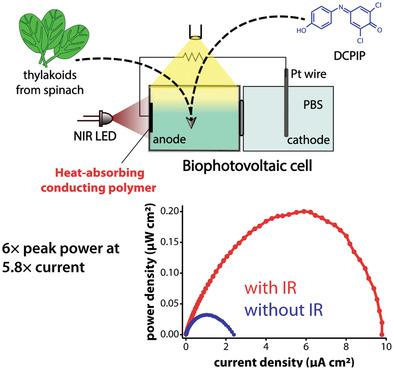当前位置:
X-MOL 学术
›
Adv. Sust. Syst.
›
论文详情
Our official English website, www.x-mol.net, welcomes your feedback! (Note: you will need to create a separate account there.)
Solar Heat‐Enhanced Energy Conversion in Devices Based on Photosynthetic Membranes and PEDOT:PSS‐Nanocellulose Electrodes
Advanced Sustainable Systems ( IF 7.1 ) Pub Date : 2019-12-29 , DOI: 10.1002/adsu.201900100 Gábor Méhes 1 , Mikhail Vagin 1 , Mohammad Yusuf Mulla 1 , Hjalmar Granberg 2 , Canyan Che 1 , Valerio Beni 3 , Xavier Crispin 1, 4 , Magnus Berggren 1, 4 , Eleni Stavrinidou 1 , Daniel T. Simon 1
Advanced Sustainable Systems ( IF 7.1 ) Pub Date : 2019-12-29 , DOI: 10.1002/adsu.201900100 Gábor Méhes 1 , Mikhail Vagin 1 , Mohammad Yusuf Mulla 1 , Hjalmar Granberg 2 , Canyan Che 1 , Valerio Beni 3 , Xavier Crispin 1, 4 , Magnus Berggren 1, 4 , Eleni Stavrinidou 1 , Daniel T. Simon 1
Affiliation

|
Energy harvesting from photosynthetic membranes, proteins, or bacteria through bio‐photovoltaic or bio‐electrochemical approaches has been proposed as a new route to clean energy. A major shortcoming of these and solar cell technologies is the underutilization of solar irradiation wavelengths in the IR region, especially those in the far IR region. Here, a biohybrid energy‐harvesting device is demonstrated that exploits IR radiation, via convection and thermoelectric effects, to improve the resulting energy conversion performance. A composite of nanocellulose and the conducting polymer system poly(3,4‐ethylenedioxythiophene):polystyrene sulfonate (PEDOT:PSS) is used as the anode in biohybrid cells that includes thylakoid membranes (TMs) and redox mediators (RMs) in solution. By irradiating the conducting polymer electrode by an IR light‐emitting diode, a sixfold enhancement in the harvested bio‐photovoltaic power is achieved, without compromising stability of operation. Investigation of the output currents reveals that IR irradiation generates convective heat transfer in the electrolyte bulk, which enhances the redox reactions of RMs at the anode by suppressing diffusion limitations. In addition, a fast‐transient thermoelectric component, originating from the PEDOT:PSS‐nanocellulose‐electrolyte interphase, further increases the bio‐photocurrent. These results pave the way for the development of energy‐harvesting biohybrids that make use of heat, via IR absorption, to enhance energy conversion efficiency.
中文翻译:

基于光合膜和PEDOT:PSS纳米纤维素电极的设备中的太阳热能转换
已经提出了通过生物光伏或生物电化学方法从光合膜,蛋白质或细菌中收集能量的方法,作为清洁能源的新途径。这些和太阳能电池技术的主要缺点是在IR区域,特别是在远IR区域的太阳辐射波长的利用不足。在这里,展示了一种生物混合能量收集设备,该设备通过对流和热电效应利用IR辐射来改善最终的能量转换性能。纳米纤维素和导电聚合物体系聚(3,4-乙撑二氧噻吩):聚苯乙烯磺酸盐(PEDOT:PSS)的复合材料用作生物混合电池的阳极,该混合电池包括溶液中的类囊体膜(TM)和氧化还原介体(RM)。通过用红外发光二极管辐照导电聚合物电极,可以在不影响操作稳定性的前提下,将生物光伏发电功率提高六倍。对输出电流的研究表明,IR辐射会在电解质块中产生对流传热,从而通过抑制扩散限制来增强RMs在阳极的氧化还原反应。此外,源自PEDOT:PSS纳米纤维素电解质中间相的快速瞬态热电组件进一步增加了生物光电流。这些结果为开发利用红外吸收热量来提高能量转换效率的能量收集生物杂交技术铺平了道路。在不影响运行稳定性的前提下。对输出电流的研究表明,IR辐射会在电解质块中产生对流传热,从而通过抑制扩散限制来增强RMs在阳极的氧化还原反应。此外,源自PEDOT:PSS纳米纤维素电解质中间相的快速瞬态热电组件进一步增加了生物光电流。这些结果为开发利用红外吸收热量来提高能量转换效率的能量收集生物杂交技术铺平了道路。在不影响运行稳定性的前提下。对输出电流的研究表明,IR辐射会在电解质块中产生对流传热,从而通过抑制扩散限制来增强RMs在阳极的氧化还原反应。此外,源自PEDOT:PSS纳米纤维素电解质中间相的快速瞬态热电组件进一步增加了生物光电流。这些结果为开发利用红外吸收热量来提高能量转换效率的能量收集生物杂交技术铺平了道路。源自PEDOT:PSS纳米纤维素电解质中间相的快速瞬态热电组件进一步增加了生物光电流。这些结果为开发利用红外吸收热量来提高能量转换效率的能量收集生物杂交技术铺平了道路。源自PEDOT:PSS纳米纤维素电解质中间相的快速瞬态热电组件进一步增加了生物光电流。这些结果为开发利用红外吸收热量来提高能量转换效率的能量收集生物杂交技术铺平了道路。
更新日期:2020-01-17
中文翻译:

基于光合膜和PEDOT:PSS纳米纤维素电极的设备中的太阳热能转换
已经提出了通过生物光伏或生物电化学方法从光合膜,蛋白质或细菌中收集能量的方法,作为清洁能源的新途径。这些和太阳能电池技术的主要缺点是在IR区域,特别是在远IR区域的太阳辐射波长的利用不足。在这里,展示了一种生物混合能量收集设备,该设备通过对流和热电效应利用IR辐射来改善最终的能量转换性能。纳米纤维素和导电聚合物体系聚(3,4-乙撑二氧噻吩):聚苯乙烯磺酸盐(PEDOT:PSS)的复合材料用作生物混合电池的阳极,该混合电池包括溶液中的类囊体膜(TM)和氧化还原介体(RM)。通过用红外发光二极管辐照导电聚合物电极,可以在不影响操作稳定性的前提下,将生物光伏发电功率提高六倍。对输出电流的研究表明,IR辐射会在电解质块中产生对流传热,从而通过抑制扩散限制来增强RMs在阳极的氧化还原反应。此外,源自PEDOT:PSS纳米纤维素电解质中间相的快速瞬态热电组件进一步增加了生物光电流。这些结果为开发利用红外吸收热量来提高能量转换效率的能量收集生物杂交技术铺平了道路。在不影响运行稳定性的前提下。对输出电流的研究表明,IR辐射会在电解质块中产生对流传热,从而通过抑制扩散限制来增强RMs在阳极的氧化还原反应。此外,源自PEDOT:PSS纳米纤维素电解质中间相的快速瞬态热电组件进一步增加了生物光电流。这些结果为开发利用红外吸收热量来提高能量转换效率的能量收集生物杂交技术铺平了道路。在不影响运行稳定性的前提下。对输出电流的研究表明,IR辐射会在电解质块中产生对流传热,从而通过抑制扩散限制来增强RMs在阳极的氧化还原反应。此外,源自PEDOT:PSS纳米纤维素电解质中间相的快速瞬态热电组件进一步增加了生物光电流。这些结果为开发利用红外吸收热量来提高能量转换效率的能量收集生物杂交技术铺平了道路。源自PEDOT:PSS纳米纤维素电解质中间相的快速瞬态热电组件进一步增加了生物光电流。这些结果为开发利用红外吸收热量来提高能量转换效率的能量收集生物杂交技术铺平了道路。源自PEDOT:PSS纳米纤维素电解质中间相的快速瞬态热电组件进一步增加了生物光电流。这些结果为开发利用红外吸收热量来提高能量转换效率的能量收集生物杂交技术铺平了道路。



























 京公网安备 11010802027423号
京公网安备 11010802027423号